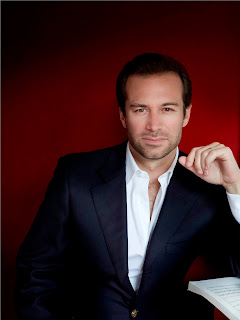Borodin, Rachmaninov, Tchaikovsky; Alexandra Dariescu, Royal Philharmonic Orchestra, Fabien Gabel; Cadogan Hall
Reviewed by Robert Hugill on May 11 2016
Star rating:
Exciting all Russian programme vividly performed
A very full platform at the Cadogan Hall on 10 May 2016 saw the Royal Philharmonic Orchestra performing a programme of large-scale Russian music with Borodin’s overture to Prince Igor, Rachmaninov’s Rhapsody on a Theme of Paganini and Tchaikovsky’s Symphony No. 5. The orchestra was conducted by the young French conductor Fabien Gabel who is music director of the Quebec Symphony Orchestra, and they were joined in the Rachmaninov by the pianist Alexandra Dariescu.
Reviewed by Robert Hugill on May 11 2016
Star rating:
Exciting all Russian programme vividly performed
A very full platform at the Cadogan Hall on 10 May 2016 saw the Royal Philharmonic Orchestra performing a programme of large-scale Russian music with Borodin’s overture to Prince Igor, Rachmaninov’s Rhapsody on a Theme of Paganini and Tchaikovsky’s Symphony No. 5. The orchestra was conducted by the young French conductor Fabien Gabel who is music director of the Quebec Symphony Orchestra, and they were joined in the Rachmaninov by the pianist Alexandra Dariescu.
 |
| Fabien Gabel - photo Gaetan Bernard |
I last heard Alexandra Dariescu performing with the Royal Philharmonic Orchestra in 2014 when, on tour to Grimsby, they performed Tchaikovsky’s Piano Concerto No.1, so it was a great treat to hear them in another dramatic Russian showcase. The work was written after Rachmaninov left Russia after the Revolution, but it has Russia in its soul notwithstanding the Paganini links. Dariescu made a strong impression from the striking opening chords, and her initial variations had great firmness of touch with great clarity in the fast fingerwork as well as wit. There was a corresponding admirable sense of detail from Gabel and the orchestra. He made the build up to the slower middle variations seem one of constant anticipation. There were, however, a couple of moments when he could have done with reining the orchestra in more, as their lively contributions masked Dariescu’s passagework. The slower section had a lovely languorous quality to it, and Dariescu showed that she had sensitivity in her fingers as well a strength. The performance from both her and the orchestra was a study in contrasts, delicacy v strength, lyricism v forceful articulation, romantic gestures v sly wit. A darkly mysterious section led up to the big tune, which was finely poetic and flexible. Then it was back to the dazzling fingerwork and exciting articulation. A sense of build up let to the outrageous fistfuls of notes at the finish.
After the interval we heard Tchaikovsky’s Symphony No. 5, the middle of his final three symphonies all of which seem to examine the workings of fate in his life. The motto theme was careful, considered and thoughtful in its initial incarnation, followed by the fluid main theme with a nice sense of movement. This was a finely crafted account of the work, rather classical in its poise with carefully shaped phrases masking the passion underneath, and we could appreciate the sweep of the grander gestures, along with great vigour and telling details. The slow movement opened with a horn solo notable for its simple elegance, though of course the music developed greater passion as the movement progressed, with Gabel really whipping the music up at the end. The third movement waltz was rather soignee and delightfully swoopy with a lovely grace to it. The final movement opened with the motto theme returning with great nobility, followed by a movement full of vivid energy. It was vibrant yet disciplined, with triumphant returns of the motto theme. Perhaps the passionate moments could have had a greater sense of white heat, but this was a performance notable for its combination of classical elegance, strong discipline and vigorous excitement.
Elsewhere on this blog:
- Strongly characterised: new music by Reiko Füting - CD review
- Intimate charm: Handel's Acis and Galatea - Concert review
- Impressive achievement, vibrant sound: Elgar's Symphony No. 1 from Trinity Laban Symphony Orchestra and members of WNO Orchesta, conductor George Jackson - concert review
- The delight of having both: Mendelssohn & Shakespeare's A Midsummer Night's Dream at Middle Temple Hall - theatre review
- Much to admire: ENO season launch - new article
- Finely sung: Folk song of the British Isles from the Armonico Consort - CD review
- Engaging enchantment: Ensemble Pygmalion's Rheinmädchen - CD review
- Highly engaging: The Sixteen in Monteverdi's 1650 collection - CD review
- Remarkable rediscovery: Classical Opera in Jommelli's Il Vologeso - Opera review
- Passionate intensity: Schnittke's Penitential Psalms - CD review
- Sheer brilliance: Charles Owen & Katya Apkeisheva in Stravinsky's Rite of Spring at Rhinegold Live - concert review
- Magical moments: On Eagles Wings, Alexander L'Estrange sung by Tenebrae - CD review
- Home










%20as%20Leporello%20and%20Erik%20Tofte%20(back%20to%20camera%20in%20garnet%20shirt)%20as%20Giovanni%20-%20Don%20Giovanni.jpg)

No comments:
Post a Comment